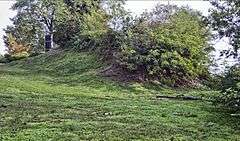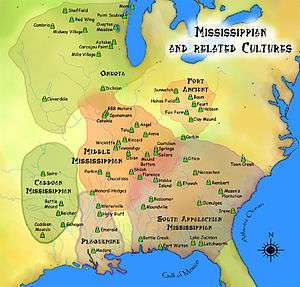Sugarloaf Mound
|
Sugarloaf Mound | |
 | |
   | |
| Nearest city | St. Louis, Missouri |
|---|---|
| Area | 1 acre (0.40 ha) |
| NRHP Reference # | 84002689[1] |
| Added to NRHP | February 17, 1984 |
Coordinates: 38°34′30″N 90°13′52″W / 38.5748728°N 90.2310482°W Sugarloaf Mound is the sole remaining Mississippian culture platform mound in St. Louis, Missouri, a city commonly referred to in its earlier years as "Mound City" for its approximately forty Native American earthen structures.[2]
One of the city’s best-known earthen structures, "Big Mound" was razed in the mid-1800s following a sale of the land to the North Missouri Railroad.[3] In preparation for the 1904 World's Fair, an additional sixteen mounds were destroyed.[2] Today, about 80 mounds are preserved in the nearby Cahokia Mounds State Historic Site directly across the Mississippi River.
Sugarloaf Mound measures approximately 40 feet (12 m) in height, 100 feet (30 m) north/south and 75 feet (23 m) east/west. It is now located entirely within the incorporated City of St. Louis, but used to be on the border between St. Louis and the formerly autonomous city of Carondelet. In 1809 the mound was used as a survey landmark when St. Louis was incorporated.[4]
A residence was constructed abutting Sugarloaf Mound in the 20th century, and portions of the mound were also impacted by a quarry and the construction of Interstate 55. Although suppressed in some online municipal records, the Sugarloaf Mound house was standing and still bore a mailing address of 4420 Ohio Street as of March 2013.[5]
It was purchased by the Osage Nation in 2009 with the stated intention of preservation.[6] The Osage Nation does not claim a direct link to the construction of the mound, but claims a kindred heritage of mound building in the American Midwest. "Preservation" does not include the existing residence, but, by 2013, seems to point to an intention to restore Sugarloaf Mound to a condition similar to its configuration before the advent of Non-Native American architectural embellishments and razings.[2]
References
- ↑ National Park Service (2009-03-13). "National Register Information System". National Register of Historic Places. National Park Service.
- 1 2 3 http://www.stltoday.com/news/local/metro/last-native-american-mound-in-st-louis-is-visited-by/article_c1e2c579-9709-52da-af69-ed82b0906571.html Last Native American mound in St. Louis is visited by tribe that purchased site
- ↑ According to Drury: The Historical Guide to North American Railroads etc, 1994, cited in Wabash Railroad, the "North Missouri ran into financial difficulty in 1871; it was succeeded in 1872 by the St. Louis, Kansas City and Northern Railroad."
- ↑ "Chief purchases Sugarloaf Mound". Retrieved 2010-02-04.
- ↑ http://www.stlouis-mo.gov/data/address-search/index.cfm?addr=4420%20%20%20%20%20OHIO%20AV&stname=OHIO&stnum=4420&parcelIdOnly=27090000500&firstview=true
- ↑ http://carnahan.house.gov/index.php?option=com_content&view=article&id=442:osage-tribe-purchases-historic-sugarloaf-mound-in-st-louis&catid=36:111th%20News

